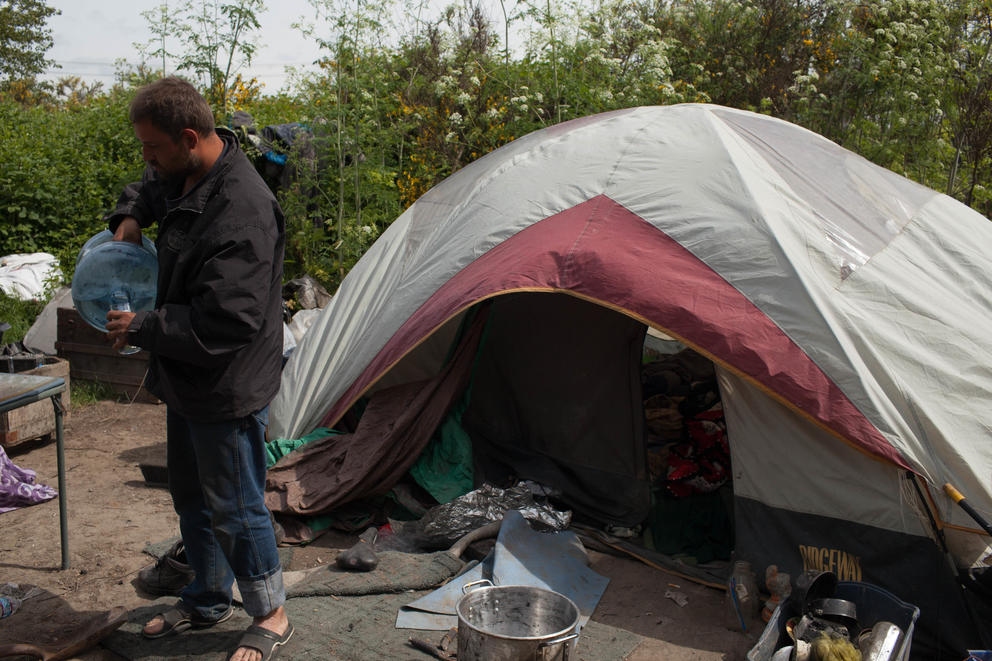In 2015, Seattle and King County each declared a homelessness State of Emergency. Both have made commendable efforts since then to intensify outreach, coordinate services, facilitate permanent housing and expand safe temporary shelter options. However, these efforts are still too little and too slow.
The 2017 “Count Us In” homeless tally identified 3,857 people living without shelter in Seattle. In 2017, Seattle added two shelters and three permitted encampments, which have the ability to serve 385 people. Amazon contributed space to shelter 200 women, children and families. Still, thousands of unsheltered neighbors continue to live in scattered overhangs, tents, vehicles and empty buildings.
This does not look like an emergency response to us. As medical and public health professionals, we stress that people will die unnecessarily if they are left on the streets, while hoping and waiting for permanent housing.
The risks for people living on the streets — and the need for emergency action — are grimly illustrated by ongoing outbreaks of hepatitis A in California. The San Diego outbreak has yielded more than 500 cases, with 70 percent requiring hospitalization and 19 deaths. Homeless people and drug users account for a large majority of cases. Outbreaks followed in Los Angeles and Santa Cruz, and the California governor just declared a state of emergency over all of the outbreaks.
Unlike hepatitis B and C, hepatitis A is spread through close personal contacts, feces, and limited access to hygiene resources. This spread can be prevented with basic sanitation and hygiene.
Unsheltered people face daunting health and healthcare challenges. A person living on the street, in an unpermitted tent or vehicle, or in an abandoned building lacks the sanitation and hygiene resources that housed people take for granted. Hepatitis A is only one of many infectious diseases that thrive in these conditions.
Additionally, a 2016 Seattle survey of people experiencing homelessness found nearly half reported mental health problems, and one-third struggled with drug or alcohol abuse. Making and maintaining connections to life-changing medical and behavioral health services is difficult or impossible when a person has an unpredictable living situation.
Stable living conditions, even temporary options such as permitted tent cities and “tiny house” villages, can alleviate these problems. Public Health — Seattle & King County did create encampment guidelines that minimize public health hazards for residents and surrounding communities. And a recent City evaluation of three permitted encampments concluded each site met or exceeded performance metrics and that case management was more effective.
We would not leave our neighbors in tenuous and unsafe living conditions for months or years while we worked on long-term solutions if their homes were destroyed by a hurricane, flood or earthquake. Why should the plight of our homeless neighbors be any different?
Make no mistake, these are our neighbors. The 2016 Seattle survey found that three-quarters of people experiencing homelessness previously had housing in Seattle or King County. About half said job loss or housing affordability issues led to their homelessness. Nearly all would accept housing if they could afford it, and only 20 percent were unable to work. These are also some of our most vulnerable and marginalized neighbors.
Family households with children represent one-quarter of people experiencing homelessness. Homelessness disproportionately affects veterans, people of color, youths identifying as LGBTQ, women and children who experienced domestic violence or abuse, and people with disabilities.
We call upon the Mayor and City Council to take bolder actions in the upcoming year, focused on creating safe shelter for all of our unsheltered neighbors, and not on shuffling them from one place to another. The “cleanups” or “sweeps” at unsanctioned campsites may improve conditions for the surrounding community. However, they do not relieve homelessness when safe alternatives are lacking and campers’ only realistic choice is another unsafe site.
Seattle urgently needs “crisis” shelter options to serve thousands of people, particularly low-barrier options for people with physical or behavioral disabilities. The City will be able to target support and navigation resources more efficiently at crisis shelter locations. Permitted tent cities can provide minimally protective shelter, and tiny house villages and RV lots offer better protection. However, these still leave people living outdoors and should be stopgap measures until indoor crisis shelter, or transitional or permanent housing is available.
Under-utilized public spaces and buildings are potential crisis shelter sites, and other public spaces could be repurposed temporarily to serve the State of Emergency. Private contributions — such as Amazon’s contributed space and the Paul Allen Family Foundation commitment of $30 million towards permanent supportive housing — should be leveraged to inspire other corporate good citizens to step forward with space or funds.
The recently proposed HOMES plan (Housing, Outreach and Mass-Entry Shelter) and head tax for at-large businesses also deserve serious consideration.
As health professionals, we would never leave patients untreated while they wait for the definitive cure. Crisis shelter is not a cure for homelessness. However, for now, we must do whatever it takes. Every person should have a practical option for safe shelter, and nobody should be abandoned to face a preventable death, disability or disease.
--
The views expressed in this commentary are those of the authors and do not necessarily reflect the official policy or position of their affiliated institutions.




